

Sumerian religion. Seleucid Empire. The Seleucid Empire (/sɨˈluːsɪd/; from Greek: Σελεύκεια, Seleúkeia) was a Hellenistic state ruled by the Seleucid dynasty founded by Seleucus I Nicator following the division of the empire created by Alexander the Great.[4][5][6][7] Seleucus received Babylonia and, from there, expanded his dominions to include much of Alexander's near eastern territories.
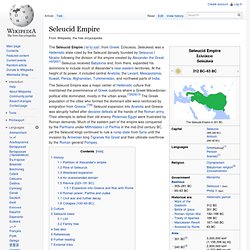
At the height of its power, it included central Anatolia, the Levant, Mesopotamia, Kuwait, Persia, Afghanistan, Turkmenistan, and northwest parts of India. History[edit] Partition of Alexander's empire[edit] Alexander conquered the Persian Empire under its last Achaemenid dynast, Darius III, within a short time frame and died young, leaving an expansive empire of partly Hellenised culture without an adult heir. Achaemenid Empire. The Achaemenid Empire (/əˈkiːmənɪd/; Old Persian: Pārsa;[9][10] New Persian: شاهنشاهی هخامنشی c. 550–330 BC), or First Persian Empire,[11] was an empire in Western and Central Asia, founded in the 6th century BC by Cyrus the Great.[11] The dynasty draws its name from king Achaemenes, who ruled Persis between 705 BC and 675 BC.
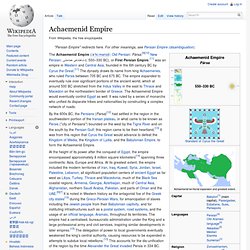
The empire expanded to eventually rule over significant portions of the ancient world, which at around 500 BC stretched from the Indus Valley in the east to Thrace and Macedon on the northeastern border of Greece. The Achaemenid Empire would eventually control Egypt as well. It was ruled by a series of monarchs who unified its disparate tribes and nationalities by constructing a complex network of roads. Neo-Babylonian Empire.
Neo-Assyrian Empire. The Neo-Assyrian Empire was an empire in Mesopotamian history which began in 934 BC and ended in 609 BC.[1] During this period, Assyria assumed a position as the most powerful state on earth, successfully eclipsing Babylonia, Egypt, Urartu/Armenia[2] and Elam for dominance of the Near East, Asia Minor, Caucasus, North Africa and east Mediterranean, though not until the reforms of Tiglath-Pileser III in the 8th century BC[3][4] did it become a vast empire.
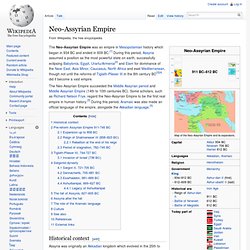
The Neo-Assyrian Empire succeeded the Middle Assyrian period and Middle Assyrian Empire (14th to 10th centuries BC). Some scholars, such as Richard Nelson Frye, regard the Neo-Assyrian Empire to be the first real empire in human history.[5] During this period, Aramaic was also made an official language of the empire, alongside the Akkadian language.[5] Historical context[edit] Assyria was originally an Akkadian kingdom which evolved in the 25th to 24th centuries BC.
Pre-reform Assyrian Empire 911-745 BC[edit] Expansion up to 858 BC[edit]
Kassite. Kassite is a rare mineral whose chemical formula is CaTi2O4(OH)2.
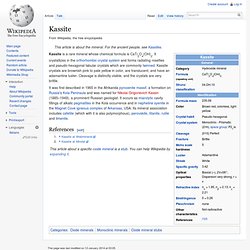
It crystallizes in the orthorhombic crystal system and forms radiating rosettes and pseudo-hexagonal tabular crystals which are commonly twinned. Kassite crystals are brownish pink to pale yellow in color, are translucent, and have an adamantine luster. Cleavage is distinctly visible, and the crystals are very brittle. It was first described in 1965 in the Afrikanda pyroxenite massif, a formation on Russia's Kola Peninsula and was named for Nikolai Grigorievich Kassin (1885–1949), a prominent Russian geologist. It occurs as miarolytic cavity fillings of alkalic pegmatites in the Kola occurrence and in nepheline syenite in the Magnet Cove igneous complex of Arkansas, USA. Babylonia. Mesopotamian religion. The god Marduk and his dragon Mušḫuššu Mesopotamian religion refers to the religious beliefs and practices followed by the Sumerian and East Semitic Akkadian, Assyrian, Babylonian and later migrant Arameans and Chaldeans, living in Mesopotamia (a region encompassing modern Iraq, Kuwait, southeast Turkey and northeast Syria) that dominated the region for a period of 4200 years from the fourth millennium BCE throughout Mesopotamia to approximately the 10th century CE in Assyria.[1] Mesopotamian polytheism was the only religion in ancient Mesopotamia for thousands of years before entering a period of gradual decline beginning between the 1st and 3rd centuries CE.
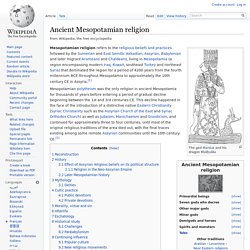
Reconstruction[edit] As with most dead religions, many aspects of the common practices and intricacies of the doctrine have been lost and forgotten over time. History[edit] Overview map of ancient Mesopotamia. Akkadian names first appear in king lists of these states circa 2800 BCE.